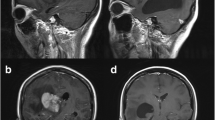Abstract
Idiophatic pneumonia syndrome (IPS) is a term used to describe lung injury following hematopoietic stem cell transplantation (HSCT) without an infectious etiology. Diagnostic criteria include multilobar infiltrates on chest X-ray, clinical symptoms consistent with pneumonia and evidence of abnormal pulmonary physiology. The incidence after autologous transplantation is low (6%) but it has a high mortality (70–80%). Treatment with high-dose steroids has been used but the results are discouraging. Etanercept is a recombinant human soluble TNF receptor fusion protein that inhibits tumor necrosis factor α (TNFα) function. Recently, promising results have been obtained with etanercept for the treatment of acute and chronic GVHD after HSCT, but there is a little information regarding adverse effects. We report a case of IPS after autologous peripheral blood progenitor cell transplantation (PBPCT) successfully treated with etanercept. The patient developed cerebral toxoplasmosis immediately after etanercept treatment with a good outcome.



Similar content being viewed by others
References
Clark JG, Hansen JA, Hertz MI et al (1993) Idiophatic pneumonia syndrome after bone marrow transplantation. Am Rev Respir Med 147:1601–6
Clark JG, Madtes DK, Martin TR et al (1999) Idiophatic pneumonia after bone marrow transplantation: Cytokine activation and lipopolysaccaride amplification in the bronchoalveolar compartment. Crit Care Med 27:1800–6
Kantrow SP, Hackman RC, Boeckh M et al (1997) Idiopathic pneumonia syndrome. Transplantation 63:1079–86
Joyce DA, Steer JH, Abraham LJ (1997) Glucocorticoids modulation of human monocyte/macrophage function: control of TNF-alpha secretion. Inflamm Res 46:447–51
Murray KM, Dahl SL (1997) Recombinant human tumor necrosis factor receptor (p75) Fc fusion protein (TNFR: Fc) in rheumatoid arthritis. Ann Pharmacother 31:1335–8
Chiang KY, Abhyankar S, Bridges K et al (2002) Recombinant human tumor necrosis factor receptor fusion protein as complementary treatment for chronic graft-versus-host disease. Transplantation 73:665–7
Kantrow SP, Hackman RC, Boeckh M et al (1997) Idiopathic pneumonia syndrome. Transplantation 63:1079–86
Bilgrami SFA, Metersky ML, McNally D et al (2001) Idiopathic pneumonia syndrome following myeloablative chemotherapy and autologous transplantation. Ann Pharmacother 35:196–201
Lee CK, Gingrich RD, Hohl RJ et al (1995) Engraftment syndrome in autologous bone marrow and peripheral stem cell transplantation. Bone Marrow Transplant 16:175–182
Ravoet C, Feremans W, Husson B et al (1996) Clinical evidence for an engraftment syndrome associated with early and steep neutrophil recovery after autologous blood stem cell transplantation. Bone Marrow Transplant 18:943–947
Madero L, Vicent MG, Sevilla J et al (2002) Engraftment syndrome in children undergoing autologous peripheral blood progenitor cell transplantation. Bone Marrow Transplant 30:355–358
Miyazaki Y, Araki K, Vesin C et al (1995) Expression of a tumor necrosis factor α transgene in murine lung causes lymphocytic and fibrosing alveolitis. J Clin Invest 96:250–259
Piemonti L, Monti P, Allavena P et al (1999) Glucocorticoids affect human dendritic cell differentiation and maturation. J Immunol 162:6473–6481
Suffredini AF, Reda D, Banks SM et al (1995) Effects of recombinant dimeric TNF receptor on human inflammatory responses following intravenous endotoxin administration. J Immunol 155:5038–5045
Bathon JM, Martin RW, Fleischmann RM et al (2000) A comparison of etanercept and methotrexate in patients with early rheumatoid arthritis. N Engl J Med 343:1586–1593
Henter JI, Karlen J, Calming U et al (2001) Successful treatment of Langerhans-cell histiocytosis with etanercept. N Engl J Med 345:1577–1578
Steensma DP, Mesa RA, Li CY et al (2002) Etanercept, a soluble tumor necrosis factor receptor, palliates constitutional symptoms in patients with myelofibrosis with myeloid metaplasia: results of a pilot study. Blood 99:2252–2254
Maciejewski JP, Risitano AM, Sloand EM et al (2002) A pilot study of the recombinant soluble human tumour necrosis factor receptor (p75)-Fc fusion protein in patients with myelodysplastic syndrome. Br J Haematol 117:119–126
Prahalad S, Bove KE, Dickens D et al (2001) Etanercept in the treatment of Macrophage Activation Syndrome.J Rheumatol 28:2120–2124
Yanik G, Hellerstedt B, Custer J et al (2002) Etanercept (Enbrel) administration for idiophatic pneumonia syndrome after allogeneic Hematopoietic stem cell transplantation. Biol Blood Marrow Transplant 8:395–400
Pasparakis M, Alexopoulou L, Episkopou V et al (1996) Immune and inflammatory responses in TNF alpha-deficient mice: a critical requirement for TNF alpha in the formation of primary B cell follicles, follicular dendritic cell networks and germinal centers, and in the maturation of the humoral immune response. J Exp Med 184:1397–1411
Marino MW, Dunn A, Grail D et al (1997) Characterization of tumor necrosis factor-deficient mice. Proc Nat Acad Science 94:8093–8098
Moreland LW, Bucy RP, Weinblatt ME et al (2002) Immune function in patients with rheumatoid arthritis treated with etanercept. Clin Immunol 103:13–21
Phillips K, Husni ME, Karlson EW et al (2002) Experience with etanercept in an academic medical center: are infection rates increased? Arthritis Care and Research 47:17–21
Johnson LL (1992) A protective role for endogenous tumor necrosis factor in Toxoplasma gondii infection. Infect Immun 60:1979–1983
Gazzinelli RT, Eltoum I, Wynn TA et al (1993) Acute cerebral toxoplasmosis is induced by in vivo neutralization of TNF-alpha and correlates with the down-regulated expression of inducible nitric oxide synthase and other markers of macrophage activation. J Immunol 151:3672–3681
Author information
Authors and Affiliations
Corresponding author
Rights and permissions
About this article
Cite this article
Gonzalez-Vicent, M., Diaz, M.A., Sevilla, J. et al. Cerebral toxoplasmosis following etanercept treatment for idiophatic pneumonia syndrome after autologous peripheral blood progenitor cell transplantation (PBPCT). Ann Hematol 82, 649–653 (2003). https://doi.org/10.1007/s00277-003-0705-2
Received:
Accepted:
Published:
Issue Date:
DOI: https://doi.org/10.1007/s00277-003-0705-2




